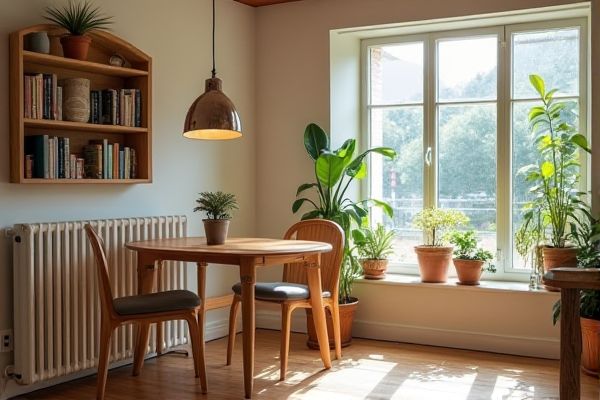
Bistro tables are typically smaller and designed for casual, intimate settings, perfect for limited spaces or quick meals, while dining tables are larger, accommodating more people for formal gatherings and extended dining experiences. Discover the key differences and choose the ideal table to enhance Your dining area by reading the full article.
Table of Comparison
| Feature | Bistro Table | Dining Table |
|---|---|---|
| Size | Small, typically 24-36 inches diameter | Large, usually 48-96 inches length |
| Usage | Casual seating, cafes, small spaces | Formal meals, family gatherings |
| Capacity | 2-4 people | 4-12 people |
| Design | Compact, often round or square | Variety of shapes; rectangular common |
| Height | Typically 28-30 inches | Typically 28-30 inches |
| Material | Metal, wood, glass; lightweight options | Wood, glass, solid surface; heavier construction |
| Portability | Light, easy to move | Heavy, usually fixed placement |
| Cost | Generally more affordable | Typically higher price range |
Introduction to Bistro Tables and Dining Tables
Bistro tables are typically small, round, and designed for casual settings, ideal for compact spaces and quick meals, often found in cafes or breakfast nooks. Dining tables tend to be larger, rectangular or oval, accommodating multiple people for formal or family meals in dining rooms. The key difference lies in size, shape, and purpose, with bistro tables emphasizing intimacy and space efficiency, while dining tables focus on capacity and versatility.
Key Differences Between Bistro and Dining Tables
Bistro tables are compact, typically round with smaller diameters between 24 to 36 inches, designed for casual or intimate settings, while dining tables are larger, rectangular or oval, accommodating more people with dimensions often exceeding 60 inches. Bistro tables usually stand at 28 to 30 inches in height and may also be available as bar-height options around 40 to 42 inches, whereas dining tables generally have a standard height of 28 to 30 inches. Material-wise, bistro tables often use lightweight metals and tempered glass for portability, contrasting with the heavier wood or stone surfaces common in dining tables for durability and formal aesthetics.
Size and Space Considerations
Bistro tables typically feature a smaller diameter, usually between 24 to 36 inches, making them an ideal choice for compact spaces such as balconies or cozy kitchen nooks. Dining tables come in larger sizes, often starting at 48 inches in length and comfortably seating four to six people, which suits spacious dining rooms or open-plan areas. Choosing between a bistro table and a dining table depends on your available space and how many people you intend to accommodate regularly.
Design and Aesthetic Appeal
Bistro tables, typically smaller with a round or square top and slender legs, offer a compact and stylish design perfect for intimate settings or casual dining areas. Dining tables, available in a variety of shapes and sizes, often feature more robust construction and intricate details that create a focal point for formal meals and family gatherings. Your choice between a bistro table and a dining table will impact the aesthetic appeal of your space, balancing functionality with the desired ambiance.
Material and Construction Comparison
Bistro tables typically feature lightweight materials such as metal, wrought iron, or wood with simpler construction geared towards compact settings and easy portability. Dining tables are often constructed from solid hardwoods like oak, walnut, or maple, emphasizing durability and stability for daily use with heavy weight support. The difference in material density directly influences their intended use, where bistro tables prioritize style and flexibility, and dining tables focus on robust construction and long-term functionality.
Seating Capacity and Comfort
Bistro tables typically seat two to four people, making them ideal for small spaces and casual dining, while dining tables accommodate four to eight or more, providing greater seating capacity for family gatherings or dinner parties. Seating comfort at bistro tables is often compact and cozy, favoring intimate settings, whereas dining tables prioritize spaciousness and ergonomic chair arrangements for extended meals. The choice between bistro and dining tables hinges on balancing seating needs with comfort preferences based on room size and intended use.
Ideal Settings for Bistro Tables
Bistro tables are ideal for small apartments, cafes, and outdoor patios where space is limited and intimacy is desired. Their compact size and often round or square tops encourage casual dining and easy conversation in cozy environments. These tables excel in settings that prioritize efficient use of space without sacrificing style or functionality.
Ideal Settings for Dining Tables
Dining tables are ideal for formal dining rooms, family kitchens, and large gathering spaces where ample surface area accommodates multiple diners and provides room for elaborate meals. Their sturdy design and variety of shapes, such as rectangular, round, and oval, support both intimate family dinners and entertaining guests. These tables often serve as the centerpiece in homes, restaurants, and banquet halls, emphasizing comfort and functionality during longer meals.
Pros and Cons: Bistro Table vs Dining Table
Bistro tables offer a compact, stylish option ideal for small spaces and casual dining, with their lightweight design making them easy to move but limiting seating capacity. Dining tables provide ample space for family meals and gatherings, supporting more chairs and varied shapes, though they require a larger area and can dominate a room visually. Your choice depends on space availability and how often you entertain, balancing the intimacy of a bistro table with the versatility and capacity of a dining table.
How to Choose the Right Table for Your Space
Choosing between a bistro table and a dining table depends on available space and intended use. Bistro tables, typically smaller and round or square with a compact footprint, are ideal for cozy corners, breakfast nooks, or small apartments where space-saving furniture is essential. Dining tables offer larger surfaces suitable for family meals and entertaining, making them perfect for spacious dining rooms but less practical in tight areas where a bistro table's versatility and size are advantageous.
 homyna.com
homyna.com